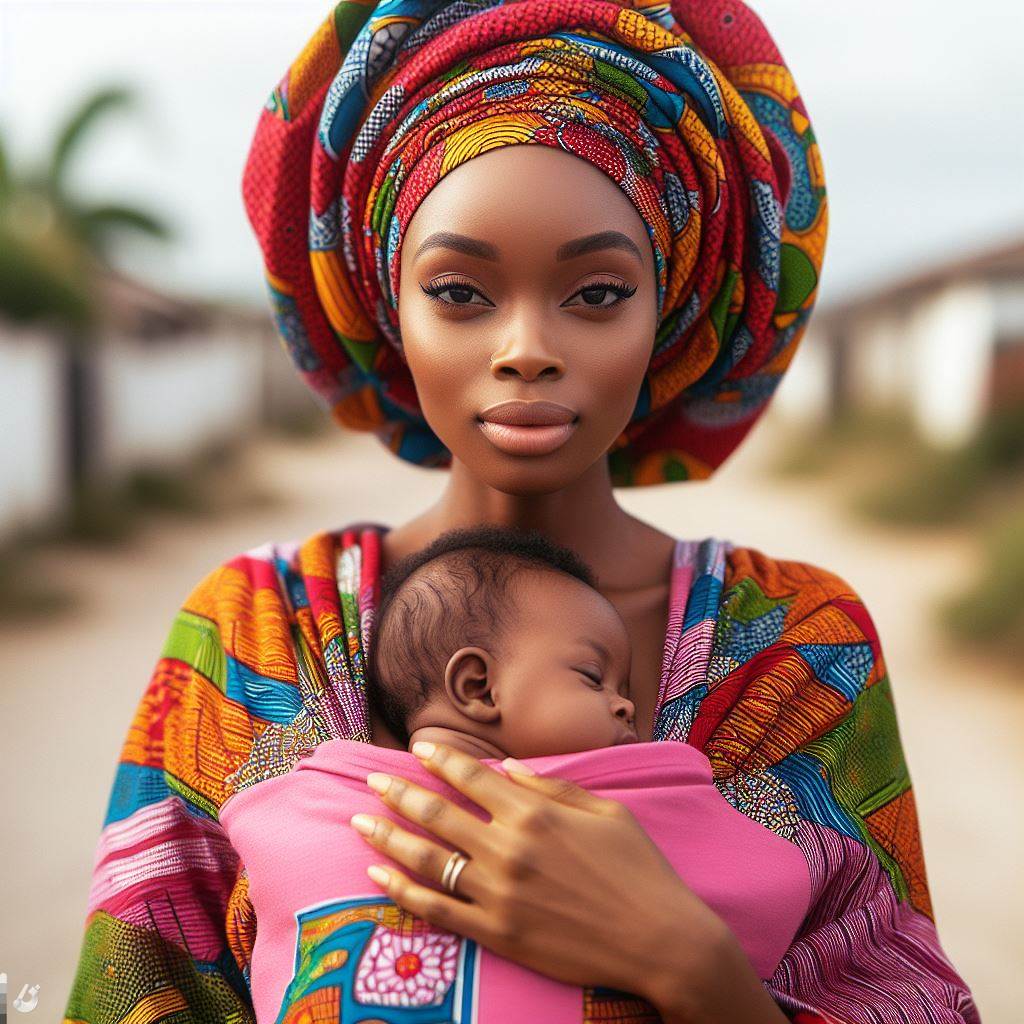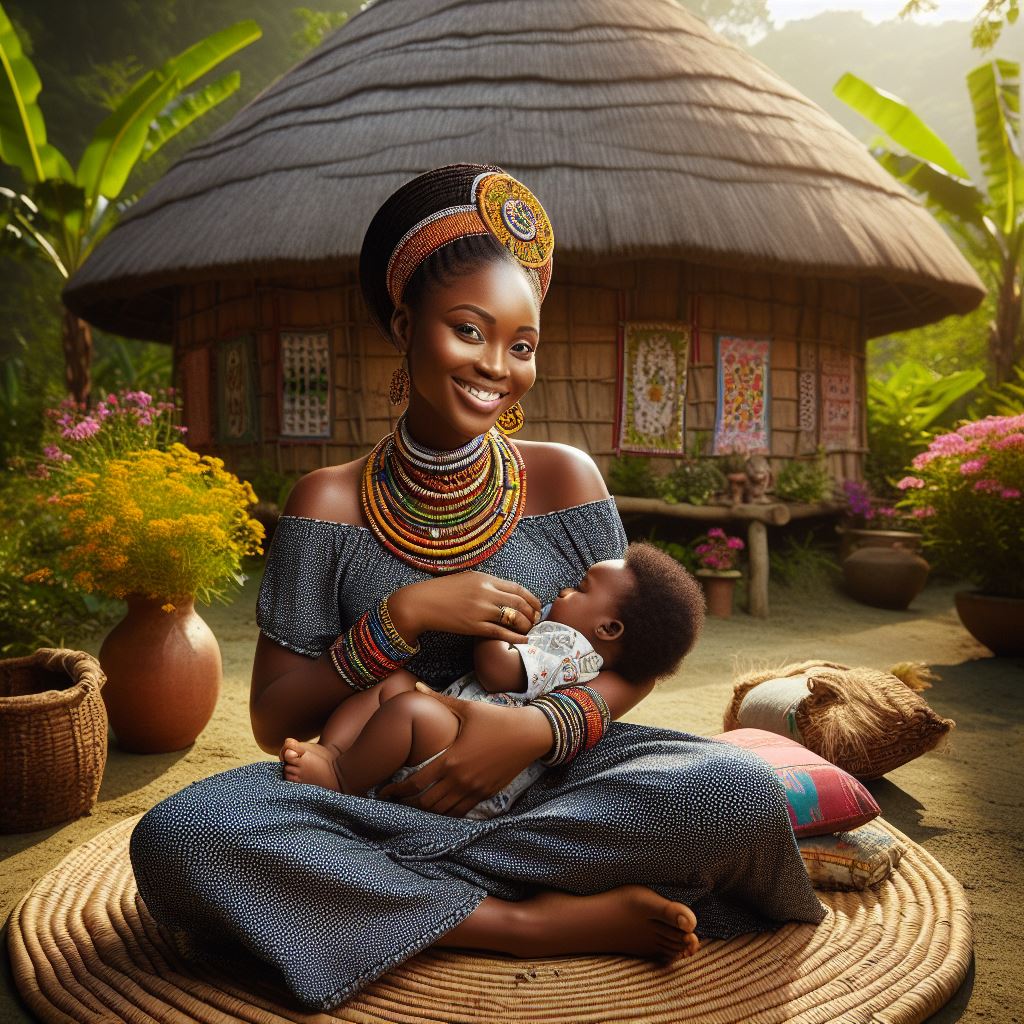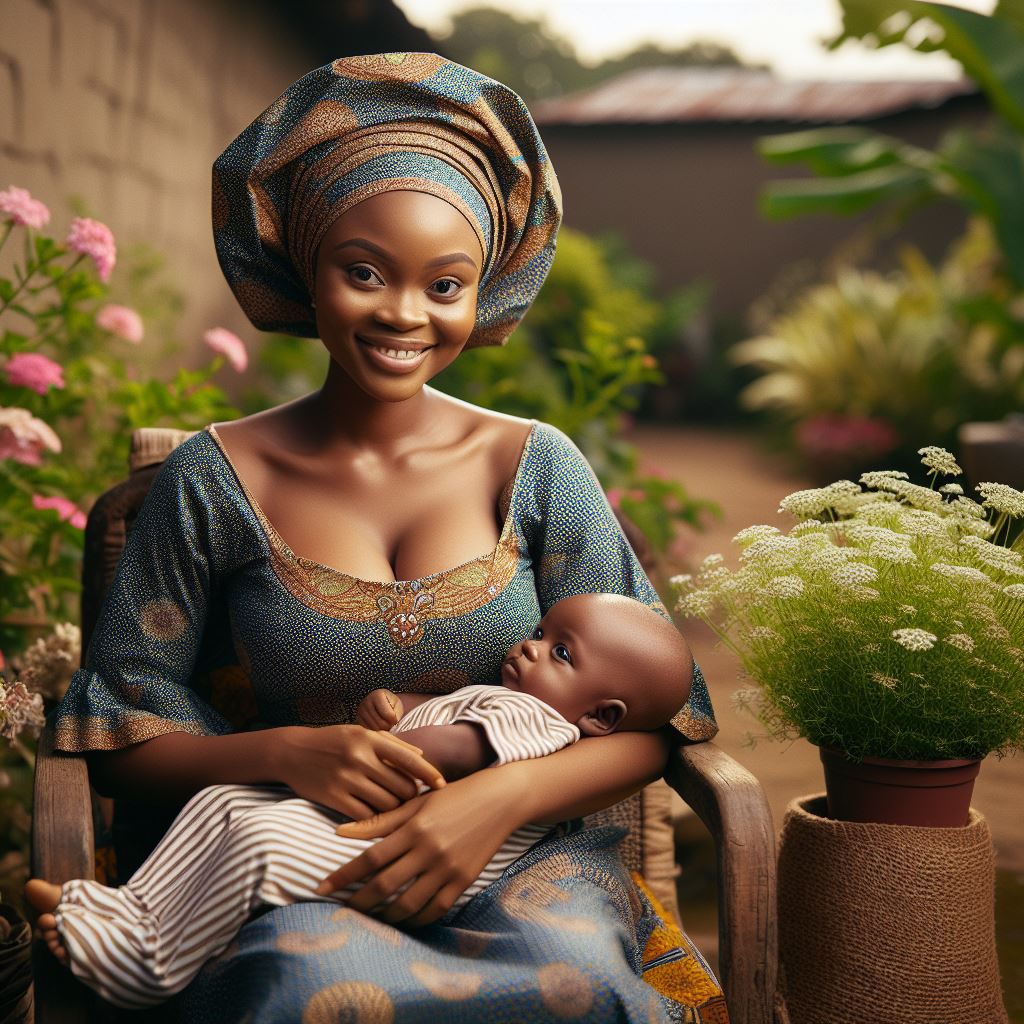Introduction
Nursing wear, specifically designed clothing for breastfeeding mothers, plays a vital role in ensuring both comfort and convenience during this crucial period.
It allows women to breastfeed their infants discreetly and confidently in public spaces, without compromising on style or fashion.
In Nigeria, a country with a rich breastfeeding culture, nursing wear is highly valued and embraced by new mothers.
Breastfeeding is deeply rooted in Nigerian culture and is viewed as a natural and healthy way to nourish infants.
Nigerian women often breastfeed their babies for prolonged periods, surpassing the recommended six months of exclusive breastfeeding.
The popularity of nursing wear in Nigeria can be attributed to the cultural significance of breastfeeding and the importance placed on supporting women during this stage of motherhood.
Nursing wear provides Nigerian mothers with the opportunity to breastfeed anytime, anywhere, without feeling exposed or uncomfortable.
It allows them to participate fully in social activities without the worry of compromising their personal style or fashion choices.
Moreover, nursing wear fosters a sense of community among breastfeeding mothers in Nigeria.
Women proudly wear nursing clothes, showcasing their commitment to providing the best nutrition for their infants.
The availability of nursing wear in a wide variety of styles, patterns, and fabrics further reinforces the idea that breastfeeding is a normal part of everyday life.
In fact, nursing wear plays an integral role in promoting breastfeeding in Nigeria.
It not only ensures the comfort and convenience of breastfeeding mothers but also celebrates the cultural significance of breastfeeding.
By providing fashionable and functional clothing options, nursing wear empowers Nigerian women to breastfeed confidently, anytime and anywhere.
Traditional Nigerian Nursing Garments
Nursing wear in Nigeria is deeply intertwined with cultural richness and heritage.
Parenting Made Just for You
Get personalized Parenting Solutions tailored to your child’s needs. Transform your parenting journey with expert guidance in 1-3 days.
Get StartedAcross diverse Nigerian cultures, traditional nursing garments showcase a vibrant tapestry of colors, patterns, and designs, reflecting both the beauty of the country and the practical needs of breastfeeding mothers.
A. Traditional Nursing Wear in Various Nigerian Cultures
- Yoruba Culture: In Yoruba communities, nursing mothers often adorn “Iro and Buba” sets with intricate embroidery and bold colors.
These two-piece outfits feature a wrapper (iro) and a loose top (buba), providing easy access for breastfeeding.
The fabrics, such as aso-oke and adire, are not only visually appealing but also celebrate the craftsmanship of local weavers and dyers. - Igbo Culture: Igbo nursing wear is characterized by wrappers tied around the waist, paired with blouses.
The wrappers can be adjusted for discreet breastfeeding, and the blouses often feature traditional motifs like the “Uli” designs.
The use of brightly colored fabrics like George and Hollandaise adds a festive touch to the nursing attire. - Hausa Culture: In Hausa communities, the “Hula” is a popular nursing garment. It is a loose-fitting, flowing gown that provides ample coverage for breastfeeding.
The Hula is often made from colorful and breathable fabrics like chiffon or cotton, making it suitable for the Nigerian climate.
B. The Practicality and Comfort of Traditional Nursing Garments
Traditional nursing wear in Nigeria is not just about aesthetics; it’s designed with functionality in mind.
The loose, flowing silhouettes of these garments offer easy access for nursing while providing comfort for both mother and child.
The use of breathable fabrics is particularly crucial in the warm Nigerian climate, ensuring that mothers remain comfortable while breastfeeding.
C. Preservation of Cultural Identity Through Nursing Wear
Nursing wear serves as a potent symbol of cultural identity in Nigeria.
By embracing and continuing the tradition of wearing these garments, mothers contribute to the preservation of their cultural heritage.
The choice of fabrics, colors, and designs carries a rich history, connecting the wearer to the stories and traditions of their community.
In a globalized world, where fashion trends often converge, traditional nursing wear in Nigeria stands as a testament to the enduring importance of cultural identity and the unique beauty embedded in the fabric of Nigerian heritage.
Read: Postpartum Care: Breastfeeding and Mom’s Health
Modern Trends in Nursing Fashion
In recent years, Nigeria has witnessed a transformative shift in breastfeeding fashion, with the emergence of stylish and functional nursing wear.
Modern mothers are embracing a fusion of comfort and style, redefining traditional norms associated with breastfeeding attire.
A. Emergence of Stylish and Functional Nursing Wear in Nigeria
Gone are the days when nursing wear was solely synonymous with oversized and drab clothing.
Today, Nigerian mothers are embracing fashion-forward designs that prioritize both aesthetics and functionality.
The emergence of stylish nursing wear reflects a cultural shift towards empowering mothers to celebrate their identities while catering to the needs of their infants.
Unveil the Perfect Name that Tells Your Family's Story
Let us help you find a name that embodies your family's values, traditions, and dreams. Our personalized consultation weaves cultural insights to create a name that's uniquely yours.
Get StartedB. Different Types of Modern Nursing Garments Available
The market now boasts a diverse range of modern nursing garments, each tailored to meet the unique needs of mothers.
From chic nursing dresses with discreetly incorporated breastfeeding access to trendy tops featuring hidden zippers and flaps, the options are both fashionable and practical.
Additionally, nursing bras have evolved, offering support without compromising on style.
These garments prioritize ease of access for breastfeeding while ensuring that mothers can express their individual sense of style.
C. Advantages of Modern Nursing Wear Over Traditional Garments
The advantages of modern nursing wear over traditional garments are manifold.
Firstly, the incorporation of discreet nursing access points eliminates the need for fumbling with layers, providing a seamless and stress-free breastfeeding experience.
Secondly, the fabrics used in modern nursing wear prioritize comfort, ensuring that mothers can move freely without sacrificing style.
Moreover, the shift towards stylish nursing wear promotes body positivity and self-confidence among breastfeeding mothers.
By embracing their changing bodies and celebrating their motherhood journey, women are empowered to embrace fashion that aligns with their lifestyles.
In short, the modern trends in nursing fashion in Nigeria reflect a cultural evolution that celebrates both motherhood and personal style.
The availability of stylish and functional nursing wear is not merely a fashion statement; it is a testament to the societal recognition of the multifaceted roles that mothers play.
As Nigerian mothers continue to redefine societal norms, the fusion of fashion and functionality in nursing wear stands as a symbol of empowerment and self-expression.
Read: Understanding Breastfeeding and Baby’s Health

Factors Influencing Fashion Choices for Breastfeeding Mothers
As nursing wear gains prominence in Nigeria, it’s crucial to delve into the factors shaping fashion choices for breastfeeding mothers.
Understanding these influences not only empowers mothers but also helps fashion designers cater to their unique needs.
A. Social Stigma and Cultural Acceptance of Breastfeeding in Public
In Nigeria, social norms and cultural perceptions play a significant role in shaping fashion choices for breastfeeding mothers.
The level of acceptance of breastfeeding in public varies across communities.
Some mothers may feel constrained by societal expectations, leading them to seek discreet and modest nursing wear.
Designers are responding by incorporating cultural aesthetics into their designs, providing mothers with stylish yet culturally appropriate options that allow for discreet breastfeeding in public spaces.
B. Influence of Media and Celebrity Role Models
Media and celebrity culture wield a considerable influence on fashion trends, and breastfeeding wear is no exception.
As celebrities proudly showcase their breastfeeding journeys on social media, they set new standards for nursing wear.
Mothers, inspired by these role models, seek stylish yet functional options.
Designers are capitalizing on this trend, creating fashionable nursing wear that mirrors the latest fashion trends while ensuring ease of breastfeeding.
By aligning with popular culture, nursing wear becomes a symbol of empowerment and normalcy for breastfeeding mothers.
C. Impact of Comfort, Convenience, and Functionality
Comfort is paramount for breastfeeding mothers, influencing their choice of nursing wear.
The impact of functionality cannot be overstated, as mothers seek garments that are not only stylish but also provide easy access for nursing.
Designers are incorporating innovative features such as discreet zippers, hidden flaps, and stretch fabrics to enhance the functionality of nursing wear.
Convenience is a driving force, with mothers opting for designs that simplify the breastfeeding process, whether at home or in public.
In essence, the factors influencing fashion choices for breastfeeding mothers in Nigeria are multifaceted, encompassing cultural, media-driven, and practical considerations.
As the demand for nursing wear continues to rise, designers must navigate these influences to create garments that empower mothers, allowing them to embrace their breastfeeding journey with style and confidence.
Read: Navigating Challenges: Common Breastfeeding Issues
Challenges and Solutions
A. Limited Availability and Affordability of Nursing Wear in Nigeria
Nursing mothers in Nigeria often face the challenge of limited access to affordable and stylish nursing wear.
The scarcity of specialized clothing for breastfeeding not only hinders their comfort but also contributes to social stigmas surrounding public breastfeeding.
To address this issue, initiatives promoting the local production of nursing wear at affordable prices must be encouraged.
Collaborations with local designers and textile industries can lead to the creation of cost-effective yet fashionable options, ensuring that every nursing mother has access to comfortable and practical attire.
B. Accessibility of Information and Resources for Nursing Mothers
Many nursing mothers in Nigeria lack adequate information about the benefits of nursing wear and where to find them.
Bridging this information gap is crucial for empowering mothers with the knowledge they need to make informed choices.
Establishing online platforms, workshops, and community outreach programs can serve as valuable resources.
By providing detailed information on the benefits of nursing wear and showcasing local options, we can empower mothers to make choices that align with their needs and preferences.
C. Suggestions for Promoting Local Production and Availability of Nursing Wear
- Government Support: Advocating for government support in the form of subsidies or grants for local businesses specializing in nursing wear can significantly boost production. This support can contribute to the affordability and availability of nursing wear for a broader population.
- Collaborations with NGOs: Non-governmental organizations focused on maternal and child health can play a pivotal role in promoting awareness and supporting local initiatives.
Partnerships with NGOs can facilitate educational programs, workshops, and distribution of nursing wear to underserved communities. - Educational Campaigns: Launching educational campaigns through various media channels can help break the stigma associated with breastfeeding and nursing wear. By normalizing the use of specialized clothing, these campaigns can contribute to a more supportive environment for nursing mothers.
In review, addressing the challenges faced by nursing mothers in Nigeria requires a multi-faceted approach.
By promoting local production, enhancing accessibility to information, and fostering a supportive community, we can create an environment where every nursing mother feels empowered and comfortable, contributing to the overall well-being of both mother and child.
Read: Breastfeeding Myths Debunked for Nigerian Parents
Style Tips and Recommendations
In the vibrant tapestry of Nigeria’s rich culture, nursing wear seamlessly weaves into the fabric of modern motherhood.
Embracing both style and functionality, here are some invaluable tips and recommendations to enhance your breastfeeding fashion experience.
A. Suggestions for finding the right nursing wear for different body types
- Hourglass Elegance: For those with an hourglass figure, opt for wrap-style nursing dresses. These designs highlight your curves while providing easy access for breastfeeding. Cinched waists and flowing skirts create a flattering silhouette.
- Pear Perfection: Embrace your pear-shaped body with A-line nursing tops. These styles gently skim over the hips, providing a comfortable and chic look. Choose patterns and colors that draw attention to the upper body, balancing out proportions.
- Athletic Allure: Moms with a more athletic build can explore fitted nursing tops paired with stylish high-waisted bottoms. This combination accentuates your toned physique while ensuring ease of access for nursing.
- Apple Comfort: If you have an apple-shaped body, consider empire-waist nursing dresses. These styles flow gracefully over the midsection while offering convenient nursing access. Look for V-neck designs to elongate the upper body.
B. Tips for coordinating nursing wear with different outfits
- Versatile Layers: Invest in versatile nursing camisoles and tanks that can be layered under various outfits. These essentials provide discreet breastfeeding access while allowing you to maintain your personal style.
- Accessorize Smartly: Elevate your nursing wear by incorporating stylish accessories like scarves, statement jewelry, or trendy nursing-friendly handbags. Accessories draw attention away from the nursing aspect and add a touch of flair to your ensemble.
- Mix and Match: Build a nursing wardrobe with mix-and-match pieces. This not only enhances your style but also provides practicality. Coordinated separates offer endless outfit combinations while ensuring comfort and accessibility.
C. How to maintain and care for nursing wear
- Follow Care Instructions: Pay careful attention to care labels on nursing wear. Many garments are designed to withstand frequent washing, but proper care ensures longevity. Follow washing instructions to preserve the fabric and elasticity.
- Rotate Your Wardrobe: If possible, rotate through your nursing wear to avoid excessive wear on specific items. This not only extends the life of your garments but also keeps your wardrobe fresh and interesting.
- Invest in Quality: High-quality nursing wear is an investment in both style and durability. Well-made pieces not only look better but also stand up to the demands of breastfeeding. Consider it a long-term investment in both fashion and functionality.
As you navigate the world of nursing wear in Nigeria, remember that style and practicality can coexist harmoniously.
Embrace your unique body type, experiment with versatile outfits, and care for your garments with diligence. In doing so, you’ll not only look fabulous but also feel confident on your breastfeeding journey.
Conclusion
Overall, nursing wear plays a crucial role in supporting breastfeeding mothers in Nigeria.
It provides comfort, convenience, and privacy, allowing mothers to nurse their babies with ease in any setting.
By embracing and supporting breastfeeding fashion, we can help create a positive and inclusive environment for breastfeeding mothers.
Let’s encourage local designers and retailers to cater to the needs of breastfeeding mothers by offering a wider variety of stylish nursing wear options.
This can help mothers feel confident and empowered while breastfeeding in public.
Furthermore, it is important for breastfeeding mothers to share their experiences and recommendations on nursing wear.
By doing so, they can inspire and guide other mothers, especially those who may be hesitant or facing challenges when it comes to breastfeeding in public.
To promote a supportive community, we can create online platforms or join existing forums where mothers can engage in discussions and provide valuable insights on nursing wear.
Sharing experiences, recommending brands, and discussing tips can help create a network of support and empowerment for breastfeeding mothers in Nigeria.
Together, let’s embrace nursing wear, support breastfeeding fashion, and create a community where every mother feels comfortable and confident while nourishing her baby.




